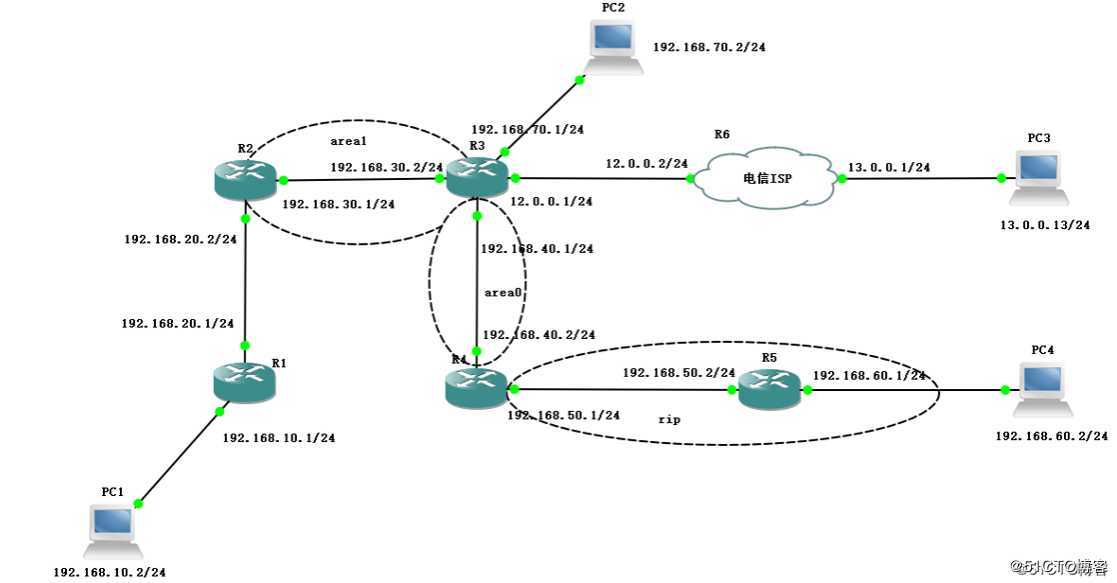OSPF高级配置实操——大型公司环境部署
Posted
tags:
篇首语:本文由小常识网(cha138.com)小编为大家整理,主要介绍了OSPF高级配置实操——大型公司环境部署相关的知识,希望对你有一定的参考价值。
一、路由重分发概念定义:即将一种路由协议中的路由条目转换为另一种路由协议的路由条目,达到多路由环境下的网络互通
理解路由重分发
1、一个单一IP路由协议是管理网络中IP路由的首选方案
2、Cisco ISO能执行多个路由协议,每一个路由协议和该路由协议所服务的网络属于同一个自治系统
3、Cisco ISO使用路由重分发特性以交换不同协议创建的路由信息
路由重分发的考虑
1、度量值
2、管理距离
重分发到OSPF域中路由的路径类型
1、类型1的外部路径(type1 external path,E1)
2、类型2的外部路径(type2 external path,E2)
二、路由重分发配置
1、配置命令
Router(config-router)#redistribute protocol 【metric metric-value】 【metric-type type-value】【 subnets】2、OSPF与RIP重分发配置实例
router rip //在rip协议中注入ospf协议
redistribute ospf metric 10 //metric为度量值,这里标准为跳数
router ospf 1 //在ospf协议中注入rip协议
redistribute rip metric 200 subnets //度量值为带宽3、OSPF重分发静态路由配置实例
router ospf 1
redistribute static metric 100 subnets metric-type 24、OSPF重分发默认路由配置实例
router ospf 1
network 192.168.0.0 0.0.0.255 area 0
default-information originate metric 10 netric-type 1
ip route 0.0.0.0 0.0.0.0 10.0.1.1三、实操
1、实验中包含静态路由、默认路由以及动态路由
2、准备环境:GNS3中的6台路由器、四台PC机
(1):按照拓扑图完成路由间的连接(注意:R3路由需要右键点击选择configure,在Slots中添加两块NM-1FE-TX工作单板。
(2):将R6路由图标样式修改为cloud云样式,这里将R6路由模拟为移动ISP。
(3):将各个设备连接并开启。
3、实验配置图
第一、配置端口环境
R1
R1#conf t
R1(config)#int f0/0
R1(config-if)#ip add 192.168.10.1 255.255.255.0
R1(config-if)#no shut
R1(config-if)#int f0/1
R1(config-if)#ip add 192.168.20.1 255.255.255.0
R1(config-if)#no shut
R1(config-if)#ex
R1(config)#ip route 0.0.0.0 0.0.0.0 192.168.20.0 //末梢网络环境配置默认路由出去,指向下一跳地址R2
R2#conf t
R2(config)#int f0/1
R2(config-if)#ip add 192.168.20.2 255.255.255.0
R2(config-if)#no shut
R2(config-if)#ex
R2(config)#int f0/0
R2(config-if)#ip add 192.168.30.1 255.255.255.0
R2(config-if)#no shut
R2(config-if)#ex
R2(config)#router ospf 1 //启用OSPF进程1
R2(config-router)#router-id 2.2.2.2 //标注router-id
R2(config-router)#network 192.168.30.0 0.0.0.255 area 1 //宣告30段落的网段,在area1中
R2(config-router)#ex
R2(config)#ip route 192.168.10.0 255.255.255.0 192.168.20.1 //做静态路由
R2(config)#router ospf 1 //启用OSPF进程1
R2(config-router)#redistribute connected subnets //直连网段20段落注入
R2(config-router)#redistribute static subnets //静态网段10段落注入
R2(config-router)#exR3
R3#conf t
R3(config)#int f0/0
R3(config-if)#ip add 192.168.30.2 255.255.255.0
R3(config-if)#no shut
R3(config-if)#int f0/1
R3(config-if)#ip add 192.168.40.1 255.255.255.0
R3(config-if)#no shut
R3(config-if)#int f1/0
R3(config-if)#ip add 12.0.0.1 255.255.255.0
R3(config-if)#no shut
R3(config-if)#int f2/0
R3(config-if)#ip add 192.168.70.1 255.255.255.0
R3(config-if)#no shut
R3(config-if)#do show ip int b
Interface IP-Address OK? Method Status Protocol
FastEthernet0/0 192.168.30.2 YES manual up up
FastEthernet0/1 192.168.40.1 YES manual up up
FastEthernet1/0 12.0.0.1 YES manual up up
FastEthernet2/0 192.168.70.1 YES manual up up
R3(config-if)#ex
R3(config)#ip route 0.0.0.0 0.0.0.0 12.0.0.2 //配置默认路由出去,指向下一跳
R3(config)#router ospf 1 //启用OSPF进程1
R3(config-router)#router-id 3.3.3.3 //标注router-id
R3(config-router)#network 192.168.30.0 0.0.0.255 area 1 //在area1中宣告30段
R3(config-router)#network 192.168.40.0 0.0.0.255 area 0 //在area0中宣告40段
R3(config-router)#network 192.168.70.0 0.0.0.255 area 0 //在area0中宣告70段
R3(config-router)#default-information originate //注入外部默认路由
R3(config-router)#exR4
R4#conf t
R4(config)#int f0/0
R4(config-if)#ip add 192.168.40.2 255.255.255.0
R4(config-if)#no shut
R4(config-if)#int f0/1
R4(config-if)#ip add 192.168.50.1 255.255.255.0
R4(config-if)#no shut
R4(config-if)#ex
R4(config)#router rip //配rip协议
R4(config-router)#ver 2
R4(config-router)#no auto-summary
R4(config-router)#network 192.168.50.0
R4(config-router)#redistribute ospf 1 metric 5 //注入ospf协议包含进程号和度量值
R4(config-router)#ex
R4(config)#router ospf 1 //启用OSPF进程1
R4(config-router)#router-id 4.4.4.4 //标注router-id
R4(config-router)#network 192.168.40.0 0.0.0.255 area 0
R4(config-router)#redistribute rip subnets //注入rip协议
R4(config-router)#exR5
R5#conf t
R5(config)#int f0/0
R5(config-if)#ip add 192.168.50.2 255.255.255.0
R5(config-if)#no shut
R5(config-if)#int f0/1
R5(config-if)#ip add 192.168.60.1 255.255.255.0
R5(config-if)#no shut
R5(config-if)#ex
R5(config-if)#router rip //配rip协议
R5(config-router)#ver 2
R5(config-router)#no auto-summary
R5(config-router)#network 192.168.50.0
R5(config-router)#network 192.168.60.0
R5(config-router)#exR6
R6#conf t
R6(config)#int f0/0
R6(config-if)#ip add 12.0.0.2 255.255.255.0
R6(config-if)#no shut
R6(config-if)#int f0/1
R6(config-if)#ip add 13.0.0.1 255.255.255.0
R6(config-if)#no shut
R6(config-if)#ex
R6(config)#ip route 192.168.0.0 255.255.0.0 12.0.0.1 //配静态路由pc机
客户机1:ip 192.168.10.2 192.168.10.1
客户机2:ip 192.168.70.2 192.168.70.1
客户机3:ip 13.0.0.13 13.0.0.1
客户机4:ip 192.168.60.2 192.169.60.1第二、进行测试连接
测试pc1是否能与pc2互联互通
测试pc1是否能与pc4互联互通
测试pc1是否能与pc3互联互通
实验到此就结束了,欢迎大家浏览观看!!!
以上是关于OSPF高级配置实操——大型公司环境部署的主要内容,如果未能解决你的问题,请参考以下文章